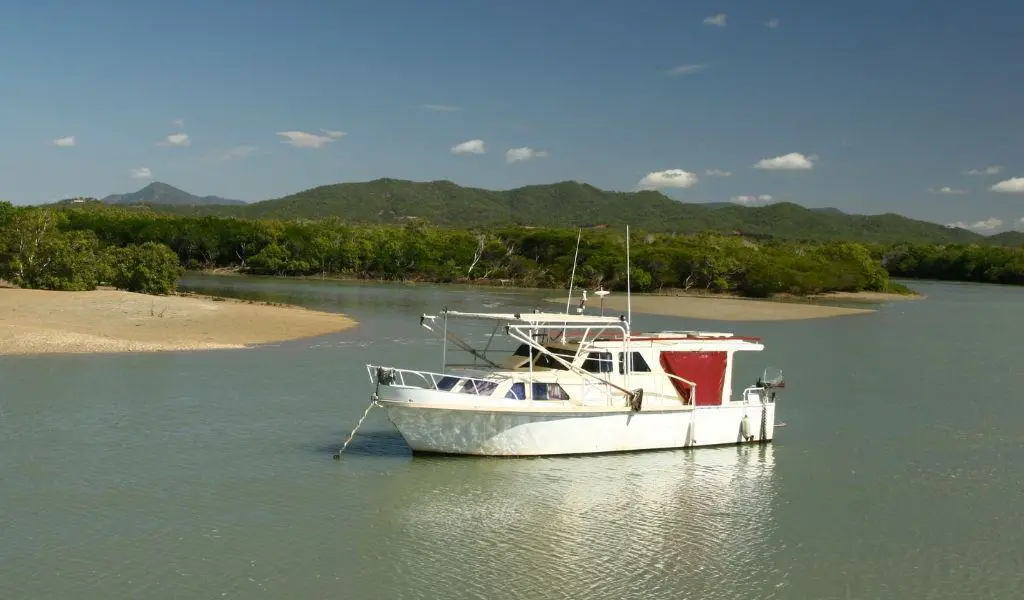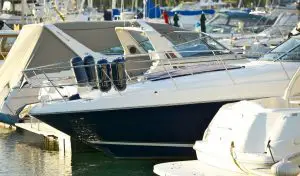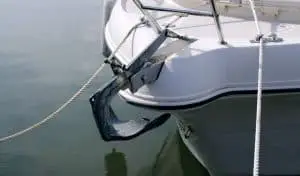Knowing how to anchor your vessel in all conditions is an essential skill that all good skippers should have. Anchoring allows you to keep your boat in a position without having to worry about drifting around because of the wind or the current. When you’re at anchor, you, of course, need to stand an effective watch, but you don’t have to worry about navigation or unwittingly shifting into a dangerous position.
Thus, anchoring is a required skill for anyone operating a boat. But, while most Hollywood movies make us think that anchoring just involves throwing a huge hook-shaped hunk of steel into the water, it turns out that anchoring is a bit more complicated than it might seem.
These days, there are so many different kinds of anchors on the market that finding the right one can be completely overwhelming for the recreational skipper. Plus, anchoring a vessel is a skill with plenty of theory behind it that needs to be understood before you ever drop anchor at sea or in a river.
To help you out, we’ve got the ultimate guide to anchoring your vessel, complete with specific information for anchoring in a river. We’ll discuss the various types of anchors and identify which ones are best for use in a river context. If that wasn’t good enough, we’ll give you some top advice on how to choose a river anchor for your boat. Let’s get to it!
Types of River Anchors
We’ve probably all seen a photo or drawing of an “anchor” in a movie, TV show, or in a kids’ book. While the anchor we all know as part of coast guard and navy emblems around the world is, indeed, a type of anchor (it’s called the Admiralty anchor), it’s far from the most commonly used one, especially nowadays. If you’re interested in a good all around river, check out my review of the BoatTector Vinyl–Coated Anchor from Extreme Max.
In fact, there are dozens of different kinds of anchors out there, each built for very specific conditions and vessels. Here are some of the more common anchors out there that are used on smaller vessels and in rivers:
Danforth Anchor
The Danforth anchor is a highly popular and relatively lightweight anchor that’s most commonly used on small boats. They were originally designed in the 1940s for use on landing craft during World War II and have gained popularity among civilians ever since.
This type of anchor features two flat triangular flukes that can dig into the seafloor. The Danforth is best used in sand and mud, yet its lightweight and compact design make it fairly easy to retrieve and store. However, it doesn’t work well in gravel or seabeds that are full of weeds. In boulders, there is a chance that it will be effective if one of the flukes is oriented correctly to act as a hook.
Hinged Plough CQR
The CQR hinged plough anchor was named because, well, it somewhat resembles a plough with a flat shaft and a sizeable angular hook-like fluke at the end. This kind of anchor is quite convenient for cruising boats because it can often stow well in a roller at the bow, making it quick and easy to place.
This kind of anchor works well in sand, rock, and mud, but many sailors find that they have some difficulty getting the CQR to actually set in the seafloor. Sometimes, the hinged plough will skip across the surface of the seafloor, while other times it will dig in and then break itself back out to the surface.
Bruce Anchor (aka Claw Anchor)
The Bruce anchor (aka claw anchor) was designed by Peter Bruce in the 1970s as an anchoring tool for ships and oil rigs. After the Bruce anchor gained popularity int the commercial world, copies of the anchor were made for smaller boats because they can be conveniently and easily stored in a bow roller.
While claw anchors can struggle to hold in weedy bottoms and in grass, they are known to hold well during tide and wind changes in sand, rock, and mud because they often turn to align with the direction of pull. That being said, they have a fairly low holding power for their weight, so are generally larger than other anchor options for a given vessel.
Grapnel Anchor
A grapnel anchor is basically a shank with a handful of tines that, when dropped to the seafloor, will pretty much always set properly and quickly. In coral and rock, a grapnel anchor usually sets fairly quickly but can be a pain to retrieve.
However, they usually don’t have the holding power required to anchor a vessel in sand, clay, or mud, which really limits the grapnel’s versatility. Additionally, folding grapnel anchors are commonly found on small boats under 20’ in length that as they can be fairly compact for storage.
Does the Type of Anchor Matter?
As you’ve probably gathered from our description of a few different anchors, the type of anchor you use does, indeed, make a difference. While all anchors are designed to do the same thing (anchor your boat), some accomplish this task better than others in certain situations.
Thus, when you choose an anchor for your boat, there are many different factors that you need to keep in mind. Coming up, we’ll walk you through the ins and outs of choosing the right type of anchor for river anchorages.
How to Choose a River Anchor
Choosing a river anchor doesn’t have to be a time-consuming process. Here are the things you should look out for when choosing the best river anchor for your boat:
1. Type and Size of Your Vessel
When it comes to anchors, the size of your vessel has a huge impact on the kind, size, and weight of the anchor you’ll need to get. Generally speaking, the larger your boat, the larger the anchor you need and the smaller your vessel, the smaller the anchor you’ll want to buy.
This makes sense, of course, as a teeny tiny little anchor isn’t likely to be able to hold a giant oil tanker in place, especially when the wind and the current conspire against it. That being said, you also don’t want to get an anchor that’s too big for your boat, either.
While you might think that a large anchor will be better for keeping a small boat in place in any conditions, there’s a limit to how big you want your anchor to be. As you can imagine, an anchor designed for an aircraft carrier is probably heavier than your powerboat, even when fully loaded, so that wouldn’t be a terribly practical choice for your river anchor.
Ultimately, you’ll want to get the largest possible anchor for the size of your boat, but you don’t want to go too big, or you’ll weigh yourself down. To determine what size anchor you need, you can use a boat/anchor chart.
These charts, like the one below, give you an idea of the minimum horizontal load you’ll need in your anchor.
| Length | Beam (ft) – Powerboat | Beam (ft) – Sailboat | For Lunch Hook (15 mph) | For Working Anchor (30 mph) | For Storm Anchor (45 mph) |
|---|---|---|---|---|---|
| 10’ | 5’ | 4’ | 40 | 160 | 329 |
| 15’ | 6’ | 5’ | 60 | 250 | 500 |
| 20’ | 8’ | 7’ | 90 | 360 | 720 |
| 25’ | 9’ | 8’ | 125 | 490 | 980 |
| 30’ | 11’ | 9’ | 175 | 700 | 1,400 |
| 35’ | 13’ | 10’ | 225 | 900 | 1,800 |
| 40’ | 14’ | 11’ | 300 | 1,200 | 2,400 |
| 50’ | 16’ | 13’ | 400 | 1,600 | 3,200 |
| 60’ | 18’ | 15’ | 500 | 2,000 | 4,000 |
As you can see, there are three “categories” of anchors listed in this chart. Often, mariners will carry more than one anchor for different circumstances. For example, a “lunch hook” is a small anchor that’s used when anchoring for a very short period of time – for lunch, per se. On the other hand, a working or storm anchor is larger, heavier, and stronger, so it’s best used when you’re sleeping, going ashore, or waiting out a storm.
Another way to conceptualize the difference between these three different categories of anchors is to think of the average wind speed that you might use them in. Generally speaking, a lunch hook will be used in winds up to 15 mph, a working anchor in winds up to 30 mph, and a storm anchor in winds upward of 45 mph.
2. Speed Of the River Current
Another factor to take into consideration when determining the size of your anchor, however, is the kinds of conditions you’ll likely face. If you spend most of your time on the water in a calm, protected area on days with good weather, you’ll have a very different anchoring experience when compared with a boater in high winds and breaking waves.
When it comes to river boating, though, a factor that many people forget to consider when choosing an anchor is the speed of the river’s current. While many popular boating rivers have currents that move so slowly, you could’ve mistaken them for a lake, others have a current that moves at a pretty fast clip.
If you spend your time in fast-moving rivers, you’ll certainly want to consider getting a storm anchor for your boat. Otherwise, you might find that it’s difficult, if not impossible, to properly anchor your boat, especially if conditions worsen.
3. Type of River Bottom
While the size of your boat is, indeed, important in choosing the size of an anchor, it’s not the only determination in choosing the type of anchor you’ll need. In fact, the type of anchor you need has little bearing on the size of your vessel. Rather, it all has to do with where you’re going, the conditions you’ll face, and the kind of seafloor or river bottom you’ll be anchoring in.
As we’ve previously discussed, some anchors fare better in different seafloor types than others. To determine what kind of anchor you need, you’ll need to figure out what kind of seafloor or riverbed is found in the areas you boat in. If you’re new to an area, you’ll want to consult a local chart or ask for advice from a reputable source, like a harbormaster or another authority in the local marina. Boating and sailing schools are a great source of information about anchoring conditions, too!
Once you figure out what kind of riverbed you’ll face, you can choose your anchor type. If you’re boating in a place with lots of mud and sand, a Danforth or Bruce anchor will probably do the trick. Boating in rivers with a rocky bottom? You might want to opt for a collapsable grapnel anchor, instead.
Weight, Size, and Holding Power of an Anchor
At this point, you probably understand and appreciate the importance of getting an anchor that’s sized appropriately for your boat and the conditions you’ll face. If you have an anchor that’s too small for your boat and the conditions you’re in, you could be in a dangerous situation.
Thus, when you’re shopping for anchors, you’ll want to look for an anchor’s “holding power” when you’re checking out its specs. As you can see from the chart we had earlier in this article, the size of the boat and the wind speeds you’re in are the main factors that decide how much holding power you need. However, the type of anchor you need depends on the kind of seafloor you’re facing, so it’s important to note that you can get different anchor types in a variety of different holding power ratings.
So, getting back to the world of holding power ratings, if you look at that trusty chart, you’ll find that you’ll need at least 125lb of holding power to anchor a 25’ boat in 15mph of wind. Therefore, since holding power is the amount of force than an anchor can withstand in certain conditions, an anchor with less than 125lb of holding power is likely to fail in this scenario.
Ultimately, you’ll need to make some assumptions about the conditions you’ll face in your boat to buy an anchor. If you’re planning on only getting one anchor for river boating, you’ll probably want to play it safe and go with a storm anchor that has enough holding power for your size boat in winds up to 45 mph.
Anchoring Line and Gear
While an anchor is an indispensable part of an anchoring system, that hunk of metal isn’t the only thing keeping your boat in place at an anchorage. In addition to an appropriately sized anchor, you’ll need to have some line and gear to hold your boat at an anchorage. For the most part, there are two main options for anchoring gear: line and chain or just chain. Here’s the difference between the two:
Chain Only
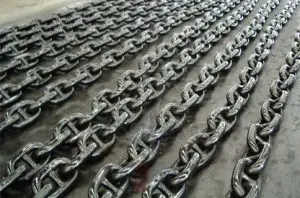
Galvanized steel chain is going to be your strongest option for anchoring your boat in any conditions. In addition to its strength, steel chain is ideal for an anchor system because the weight of the metal helps lower the angle of pull that’s put on the anchor, increasing the likelihood that the anchor will stay in place or perhaps even sink it further into the seafloor.
As you can imagine, however, a chain is only as strong as its weakest link, so we have to understand the advantages and disadvantages of the different kinds of chain links before we buy them. For the most part, steel chain comes in three types: proof coil, BBB, and hi-test.
Proof coil is the most common type of chain link and is considered to be adequate for most marine purposes. BBB, which is also known as “triple B” or 3B features shorter links that are thicker than the proof coil variety. These stockier links are slightly stronger than proof chain’s, so they’re often found on windlasses.
The third and final kind of chain link is “hi-test,” which is made from a type of hardened steel. This kind of chain is stronger than proof coil while also being lighter, so it’s a fan favorite among anyone looking to cut weight.
For most people, however, proof coil will be more than adequate and will be the most economical option. That being said, it’s important to keep in mind that the main drawback to using steel chain for your anchor line is the weight and bulk of the material, so some people might opt to use the line and chain option instead. Let’s take a look at that next. Check Pricing on Amazon
Line and Chain
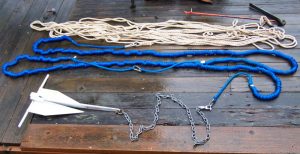
Since chain anchor set-ups tend to be heavy and bulky, many small boat skippers opt to use a line and chain combination instead. Basically, the line is used as a replacement for the vast majority – but not all – of the chain that you would use for anchoring your boat. By cutting down on the amount of chain for your anchoring, you can save weight and bulk aboard your boat.
However, some chain is required for a strong anchor. The weight of steel chain, as we’ve mentioned, helps keep a favorable angle of pull on your anchor so that it digs further into the seabed and doesn’t rip out. Thus, while you might be tempted to go for a line-only anchor set-up, it’s not recommended.
Learn how to splice your rope and chain together (article link).
How Much Chain Should I Have?
Instead, you should have either at least one foot of chain for each foot of boat length or at least one pound of chain for each pound of anchor length. Regardless of which measurement option you choose, though, it’s better to err on the side of caution and get more chain that you think you might need. Generally, you should have a minimum of 10 to 15 feet of chain, though, even if your boat is smaller than that.
Additionally, when you buy your chain, you’ll want to make sure that your chain links are at least half the width of your line (we’ll get to how you determine that in a bit). If you get chain that’s any smaller, it might not be strong enough for your boat. Any bigger, and you’ll be carrying around a lot of extra steel.
What Kind of Line Should I Get?
When it comes to choosing a material for the line, you’ll probably want to go with nylon instead of polyester or some other alternative material. Nylon has many advantages for maritime use, including good shock absorption, light weight, flexibility, high weight-to-strength ratio, and the fact that it sinks when wet.
However, not all nylon line is created equal. Especially when it comes to anchoring, line thickness is incredibly important as thicker lines can handle more weight load than thinner lines. But, at the same time, you don’t want to be lugging around a super thick line for your tiny little dinghy, so you want to make sure you’ve got the right line thickness for your vessel.
The general rule of thumb for anchor line thickness is that you want 1/8” thickness of your rope for every 9 feet of boat length. Thus, with a simple calculation, you can quickly and easily determine the minimum thickness of your anchor line.
Line and Chain Attachments
Finally, it’s important to ensure that you’re using a strong line-chain attachment system or your anchor system might break at the line/chain interface. Most seasoned skippers would recommend either a marine-grade stainless steel or a hot-dipped galvanized steel swivel or shackle for the connection point between your line and chain. Check Pricing on Amazon
How Much Line or Chain Do I Need?
Once you decide on a full chain or a line and chain anchoring system, it’s time to figure out how much anchor line – called “rode” – you’ll need aboard your boat. The general rule of thumb is that you should have at least 8 feet of line for every one foot of water that you anchor in. The ratio between the amount of line you put out and the depth of your anchorage is called the “scope.” In this instance, your scope is 8:1.
All of this extra line in your scope is necessary to account for the rise and fall of the tide and the forces of the wind, so it’s important that you don’t fudge this calculation, or you’ll be dragging anchor before long. That being said, unless you plan on going to the same anchorage on every outing, you need to plan to have enough rode to accommodate the deepest possible water that you’ll anchor in. For the most part, the longer your rode, the better, but there’s a limit to how much you can carry.
To play it safe, we’d go with a scope of at least 10:1, which is better in windy conditions as it allows for a better angle of pull on your anchor. Most pleasure cruising boats will find that 300 feet of rode is sufficient for most of their applications as it allows them to anchor in 25 feet of water with a scope of 10:1. If you find that you often anchor in deeper locations, you’ll want to consider a longer rode.
Do Homemade or DIY Anchors Work?
These days, there are a lot of people looking to save some money by creating their own equipment. Some people have tried to make their own anchors to cut down on the costs of boat ownership with varying degrees of success.
While some people have managed to create some decent homemade anchors, we can’t recommend this as a great option. Sure, some folks with great design and building skills have made quality DIY anchors, but when it comes to something as important as an anchor, you don’t want to place your bets on a build-it-at home option that you saw on YouTube.
Since an anchor can save your life in an emergency, such as if your engine failed and you were drifting toward rocks, we don’t want to have to hope that the cheap anchor we made will work. Instead, we want to head out onto the water with full confidence in our gear, especially the gear in our emergency kit. Thus, while you can make your own anchor, is it really worth it in the long run?
In Summary
Ultimately, an anchor is a critical part of any maritime equipment list. Having a quality anchor that you know how to use can make a huge difference in an emergency or if you’re anchored in a safe harbor during a storm. Since you have so much riding on your anchor, it’s important that you know what kind of anchor and rode you need for your boating adventures so you can spend less time focused on your gear and more time enjoying your time on the water.

